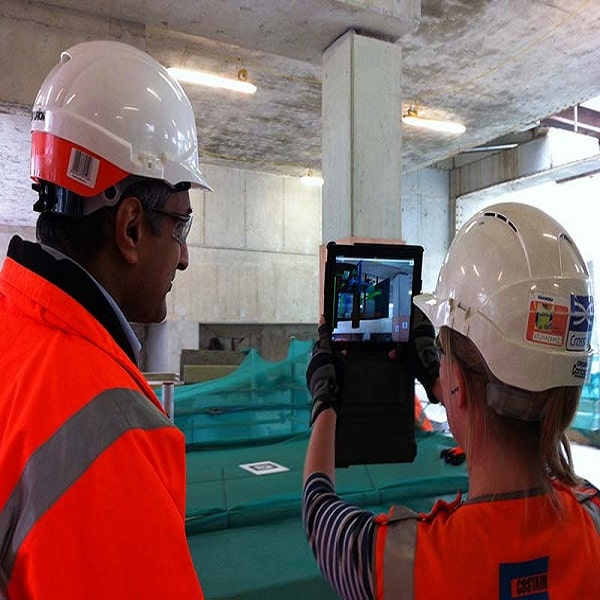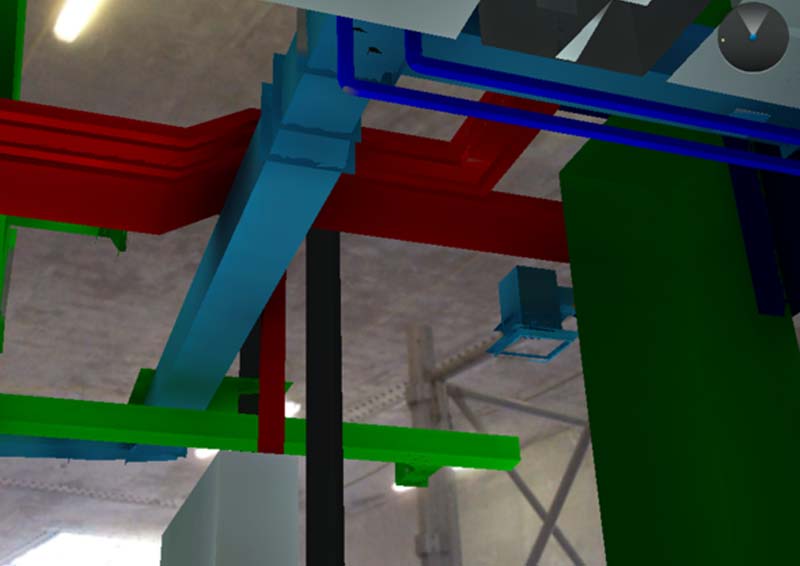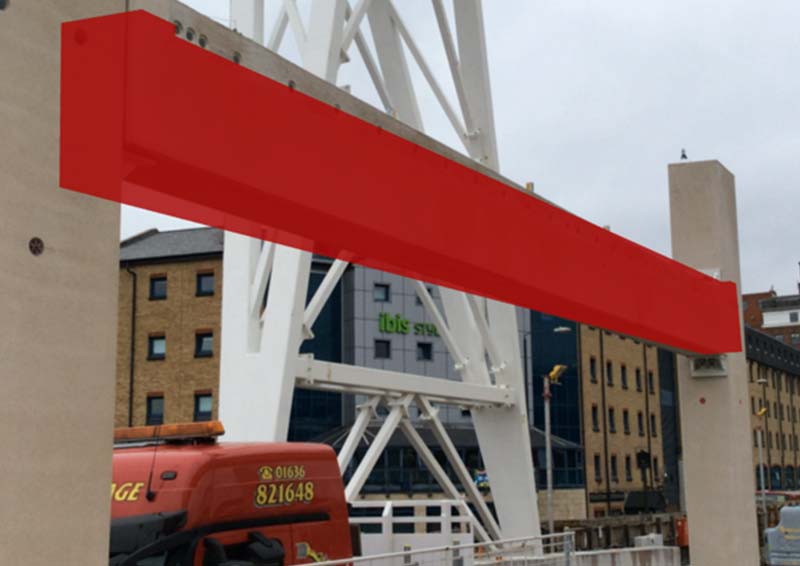The concept of using an electric display that overlays data onto real life was first mentioned in 1901 by author L Frank Baum. It was not until 1990 until the term ‘Augmented Reality‘ was coined by Thomas P. Caudell from Boeing.
Augmented reality (AR) is defined as a live direct or indirect view of a physical, real-world environment whose elements are augmented (or supplemented) by virtual computer-generated sensory input such as sound, video, graphics or GPS data.
The ‘Sword of Damocles’ head-mounted display was the original augmented reality headset, circa 1968. Within construction, the idea of using AR to aid with visualising building projects is not a new concept.
Using computer generated images of a structure superimposed into the real life intended location was demonstrated by Trimble back in 2004. Gartner recognised AR as an emerging technology on their famous Technology Hype Cycle a year later in 2005, however, since this early promise AR has been stuck in the ‘Trough of Disillusionment’ since 2012. Gartner still predicts that the technology is 5-10 years from mainstream adoption and if construction is a trailing industry it could take even longer before it truly revolutionises construction sites.
Why has the technology failed to become more than a gimmick, only finding its way into the hands of fighter pilots and military special forces? With Google famously failing to get AR to the masses through its Google Glass project, what does this mean to its future potential for adoption within the construction industry?
This article outlines the current landscape of AR technology, and argues that the blockers holding back adoption of the technology are quickly eroding. Outline lessons learnt from trial implementations by Bechtel Infrastructure and Crossrail the paper also identify use cases for the construction industry which hold the promise for improved productivity and health and safety on site.
How does AR work?
In order to assess the potential impact of AR in construction it is important to first understand the technology components that form an AR system. It can then be identified how well these systems work within construction given the unique characteristics of a typical construction site.
An AR system is made up of the following components:
- AR Display: How the user observes and interacts with the AR content. The most common types of display are tablet devices (e.g. iPad or Windows Surface), AR Glasses (e.g. Vuzix M-100, Atheer AiR), and smart phones (iPhone, Android devices).
- Visual Rendering Engine: How the AR content is generated.
- Content Management System (CMS): How the AR content is managed and delivered to the AR Display.
- Location tracking: How the AR content is positioned relative to physical real-world environment. There are many types of location tracking methods including Barcode, GPS, QR codes, image recognition, feature point recognition, edge based tracking, Manometer tracking and RGB sensors.
Implementing AR in construction
The following challenges were identified by Bechtel Infrastructure whilst undertaking an AR trial at Custom House station for the Crossrail project and also a previous trial on the Crossrail West project.
The custom house project involved the use of AR to track the progress of installation of pre-fabricated super-structure components using an AR application developed by Bechtel Infrastructure. The prior Crossrail West project used AR to verify the construction methodology and position of a critical transfer deck.
Construction sites are busy, dirty, dangerous places, often in remote locations. This brings a number of challenges that are fairly unique to this industry which make the end-to-end solutions offered by many vendors unsuitable. Health and safety is the primary concern as there is a real danger that a person using an AR display on site will be distracted by the augmented content and fail to fully engage with their surroundings.
The construction industry struggled for a long time with how to safely allow the use of phones, and more recently, tablet devices on site. Whilst most contractors now have sensible policies to govern phones and tablets the author does not know of any that have implemented similar policies that allow the safe use of AR devices.
Construction sites often suffer from poor or no data connections which provides a challenge with getting the AR content to the AR display at the point of use. Some AR systems do have local storage capability allowing the user to cache the AR content prior to accessing the site and this can then be accessed via Bluetooth or a wired connection when required.
As with all technology implementations cost is always a consideration. Many of the AR solutions available today a prohibitively expensive for widespread use. This limits the practical use of AR systems.
The following additional factors were identified during the AR trials which need consideration when applying AR on construction sites:
Business logic challenges
Some vendors provide end-to-end branded solutions that contain each of the AR components outlined above. However, to use AR to solve a problem then business logic needs to be applied to the CMS, for example to retrieve the correct product data sheet for a piece of equipment that needs to be maintained.
AR vendor CMS solutions are not currently well integrated with BIM (Building Information Modelling) systems in use within the construction industry. This integration gap acts as a barrier to adoption of AR in the construction industry.
Many construction companies have implemented pilot AR projects on site but the complexity involved with delivering relevant business logic based information to the AR system makes it hard to scale the solution up for widespread use.
Limited use of contextual information
Google Glass-type notification and site inspection systems that create a 2D AR experience have great potential within construction but are generally considered as simply hand-free alternatives to viewing data. This provides only limited benefit over using a standard tablet device.
If the AR systems made better use of sensor data to be truly contextual and not just another medium for information access, then the benefit would be much greater and would make AR a more compelling proposition.
Complexity and capabilities of tracking technologies
There are numerous AR tracking technologies available depending on the AR system being used and the site environment. Each technology has its merits and ideal implementation and selection criteria which need to be considered carefully. Selecting the wrong tracking method could impact the accuracy of the positioning of the AR content. One solution is to use a combination of tracking technologies which work together to improve positioning and additionally allows the tracking to continue to work if one or a number of the tracking methods temporarily fails.
Level of detail required for AR content
How real does AR content need to be for construction is a key question that has not yet fully been answered by industry. The major AR solutions that are being targeted towards the gaming industry require photo-realism and very high refresh rates to trick the user into believing that the augmented content is real.
For construction however, photo-realism is not usually required by the user as the level of detail is purely a visual guide to access information. This is good news for the industry since the perceived overhead of applying advanced rendering techniques to AR content technology are non-existent.
On the Crossrail custom house trial, the users found that it was better to deliver a very simple block model of the AR content rather than a highly rendered version, this also had the advantage of generating less data which reduced overhead on data transfer. Looking further into the future more advanced AR technology win development by companies such as Magic Leap involving a more direct feed of visual information to the retina, will eventually mean that basic rendered model objects will appear to actually be in situ as the eye perceives the object to physically be occupying the real world space.
Human interface issues challenges for users wearing safety gloves
The huge variety of AR displays and interfaces potentially provide for a wide range of opportunities but also throw up a lot of questions that have not fully been explored by the industry.
Should we be limited to tablets/smart phones (hardware bulk considerations), wearables (PPE protective eyewear considerations), immersive AR caves (practicability considerations), site-based data kiosks (unnecessary), or mid-air gesture recognition (mad arms syndrome) or look further afield by using adaptive flexible screen technology and e-ink displays to deliver content reflecting a more traditional delivery mechanism such as blueprint that change on location to display required information and 3d models?
Positional accuracy of field AR devices
Windows PC-based AR accuracy has proven to be sub mm perfect for automotive industry use but to date mobile devices have not been able to match this. Mobile hardware/sensors packages (iPads, project tango etc.) are improving such that we will soon have the ability for equally accurate tracking on construction sites.
Once the sub mm threshold of accuracy has been breached – and at distance – then AR for construction will likely move beyond 3D/4D visualisation to being used by various tradesmen’s requirements for location and contextual information retrieval thus better justifying the outlay costs of the AR system.
Construction AR use cases
(Image: AR used in Crossrail)
The following is a list non-exhaustive list of identified use cases for AR in construction:
- Stakeholder visualisation using 2D or 3D models.
- 4D field driven project planning: The 3D construction sequencing model is overlaid against the real-world site environment so the construction sequence can be checked and verified on site.
- Safety viewer: Specific safety or hazards can be augmented over the real-world site environment using 3D pop-up icons
- Project Technical Requests viewer: Non-conformance or requests for information (RFIs) can be augmented over the real-world site environment using 3D pop-up icons.
- Drawing access: 2D/3D virtual blueprints accessed on site.
- Systems training/Operations and Maintenance: Systems operations and maintenance information overlaid over the installed equipment on site to facilitate familiarisation of systems during handover and operations & maintenance.
Conclusion
Whilst specific small scale trials using AR, like those at Crossrail Custom House, demonstrate the potential value of AR to construction there are numerous factors and considerations that limit its suitability for large scale deployment.
Technology advancement within the AR industry is rapid with more capable products being released on a regular basis. Given the size and number of technology companies investing in the AR industry it is certainly a technology trends which will continue to grow and will at some point have a profound effect on our lives, on business and on commerce.
Many of the challenges outlined above with implementing AR within construction will need to be solved before mass adoption is likely to occur. The construction industry will need support for the AR and BIM software vendors in solving these problems. Developing capable generic AR solutions that have not been developed with the specific requirements of construction in mind are likely to be difficult to successfully deploy within the construction industry, particularly at large scale.
One example capability of AR solutions not extensively explored which could bring value to construction use cases is augmenting locations with sound. Rather than overlaying data or models into the user’s field of view, voice could be used and this could prove less distracting and therefore safer within a site environment.
In 2015, the AR landscape has come to understand that construction (as opposed to logistics and industrial warehouse-type applications of the tech), AR requires significantly different perspective to really prove beneficial to the industry beyond simple visual representation.
For example, visual checklists are an excellent introductory starting point for AR companies with no relative construction experience but while fairly straightforward to create for other step by step processes in logistics/warehouse apps, more understanding is required from a construction project data and user experience perspective to justify the expense. For construction to immerse themselves in AR, AR companies need to immerse themselves in their client requirements.
AR will eventually play a major part in delivery of construction projects once the key blockers are address and the construction use cases are fully understood. Ultimately it could be an invaluable tool across all the construction supply chain to augment the construction site with business and safety critical information allowing site teams to deliver projects more efficiently and more safely. If engineers can retrieve augmented information 2D, 3D, nD, video or voice to understand and access what is currently hidden information then the early promise can be fulfilled.
Source: designingbuildings












